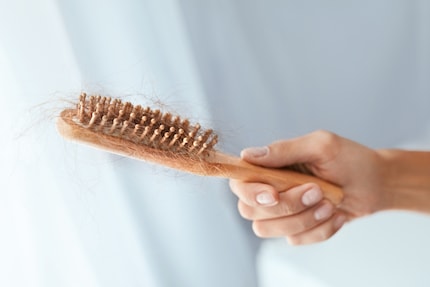
Guide
How to cut your child’s hair: simple tips from a pro
by Katja Fischer

If it feels like there is more hair on your brush than on your head, it's likely that your hair is falling out. Here you can find out how to recognise whether you are actually affected, what the cause might be and what types there are.
We all lose hair. There's nothing pathological about it at first. Your hair goes through a three-phase cycle. A two to six-year growth phase is followed by the transition phase, in which the root pushes towards the surface of the scalp. This is followed by a two to four month resting phase. No more metabolism takes place here. The hair slowly loosens and eventually falls out through washing or combing. Around 18 per cent of our mane is in this resting phase. If it reaches 20 per cent, we speak of hair loss, also known as alopecia.
If you lose up to 100 hairs per day, you are within a healthy range. The best way to find out whether you are exceeding this value is to count all the hairs that you lose on your pillow, in your brush or in the sink of your shower every day for three weeks. If there are really more, you should see a dermatologist. They can tell you what type of alopecia you have and what the possible causes might be.
Hair loss occurs when the growth phases of the hair are shifted, the formation of new hair is prevented or the hair formation sites (follicles) have been destroyed. You can differentiate between permanent and temporary alopecia: Permanent hair loss requires partial or complete destruction of the follicles. With temporary hair loss, on the other hand, the affected person only suffers from temporary loss, which is usually due to psychological stress, for example. This causes the follicles to enter the resting phase. The result: the hair thins out or does not grow back at all. As soon as the stress subsides, hair growth returns to normal. Medication, zinc or iron deficiency, infections, immune system disorders, operations under general anaesthetic, pregnancies, menopause, skin diseases, poisoning
or a malfunction of the thyroid gland can be causes

There are many types of hair loss. The following are among the three most common:
Hereditary hair loss
This type is more common in men than in women. This is primarily due to a hypersensitivity of the hair formation centre to the steroid hormone dihydrotestosterone (DHT), which is found in the scalp and is produced by the conversion of the sex hormone testosterone. This is an intolerance that is passed on genetically and leads to the roots no longer being supplied with sufficient nutrients. This greatly shortens the growth phase of your hair and it falls out more quickly. However, you won't go completely bald, the hair on your temples and the back of your head will remain. An excessive amount of the male sex hormone also leads to hair loss in women. The hair on the crown of the head becomes thinner and the forehead hairline recedes.
Circular hair loss
This form is equally common in men and women, although young people are increasingly affected. Those affected lose their hair within a clearly defined area, usually due to a disorder of the immune system. The follicles do not die. However, growth is disrupted by inflammatory cells in the scalp. In this case, the hair can grow back at any time.
Diffuse hair loss
In contrast to circular hair loss, diffuse hair loss does not affect a specific area. Your entire hair becomes thinner. There are many reasons for this: Among other things, metabolic diseases, colouring and other chemical care products as well as mental suffering can be responsible.
Once you know the type and cause of your hair loss, there are various treatment options to choose from. Only your dermatologist can tell you which of these are suitable for you.
Click on the black "Follow author" button next to my profile to make sure you don't miss any of my articles. 😊
As a massive Disney fan, I see the world through rose-tinted glasses. I worship series from the 90s and consider mermaids a religion. When I’m not dancing in glitter rain, I’m either hanging out at pyjama parties or sitting at my make-up table. P.S. I love you, bacon, garlic and onions.
Practical solutions for everyday problems with technology, household hacks and much more.
Show all